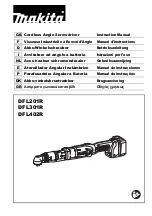
5
• Only use the battery with a charging system specified by the manufacturer/supplier.
• Do not short-circuit a battery or allow metallic or conductive objects to contact both
battery terminals simultaneously.
• Dispose of used batteries promptly according to the manufacturer/supplier’s
instructions.
• Improper battery use may result in a fire, explosion, or other hazard.
• Battery usage by children should be supervised.
wArNiNG:
Never attempt to open the battery for any reason. If battery case is
cracked or damaged, do not insert into charger. Do not crush, drop or damage battery.
Do not use a battery or charger that has received a sharp blow, been dropped, run over
or damaged in any way (i.e., pierced with a nail, hit with a hammer, stepped on).
Damaged batteries should be returned to service center for recycling.
sAfeTy wArNiNGs AND iNsTrUCTiONs - CHArGiNG
1. This manual contains important safety and operating instructions.
2. Before using battery charger, read all instructions and cautionary warnings on battery
charger and product using battery.
CAUTiON: To reduce the risk of injury, use
charger only with this product. Batteries in other products may burst causing personal
injury or damage.
3. Do not expose charger to rain or snow.
4. Use of an attachment not recommended or sold by Black & Decker may result in a
risk of fire, electric shock, or injury to persons.
5. To reduce risk of damage to electric plug and cord, pull by plug rather than cord
when disconnecting charger.
6. Make sure cord is located so that it will not be stepped on, tripped over, or otherwise
subjected to damage or stress.
7. An extension cord should not be used unless absolutely necessary. Use of improper
extension cord could result in a risk of fire, electric shock or electrocution.
a. Two-wire cords can be used with 2-wire or 3-wire extension cords. Only round
jacketed extension cords should be used, and we recommend that they be listed
by Underwriters Laboratories (U.L.). If the extension is to be used outside, the cord
must be suitable for outdoor use. Any cord marked for outdoor use can also be used
for indoor work. The letters “W” or “WA” on the cord jacket indicate that the cord is
suitable for outdoor use.
b. An extension cord must have adequate wire size (AWG or American Wire Gauge) for
safety, and to prevent loss of power and overheating. The smaller the gauge number
of the wire, the greater the capacity of the cable; that is, 16 gauge has more capacity
than 18 gauge. When using more than one extension to make up the total length, be
sure each extension contains at least the minimum wire size.
Chart for minimum wire size (AWG) of Extension Cords
Nameplate rating AMPS – 0 – 10.0
Total Extension Cord Length (ft) 0-25 26-50 51-100 101-150
(0-7,6m) (7,6-15,2m) (15,2-30,4m) (30,4-45,7m)
Wire Gauge 18 16 16 14
8. Use only the supplied charger when charging your tool. The use of any other charger
could damage the tool or create a hazardous condition.
9. Use only one charger when charging.
10. Do not attempt to open the charger. There are no customer serviceable parts inside.
Return to any authorized Black & Decker service center.
11. DO NOT incinerate the tool or batteries even if they are severely damaged or
completely worn out. The batteries can explode in a fire.
12. Do not incinerate the battery even if it is severely damaged or is completely
worn out. The batteries can explode in a fire. Toxic fumes and materials are created
when lithium ion batteries are burned.
13. Do not charge or use battery in explosive atmospheres, such as in the presence of
flammable liquids, gases or dust. Inserting or removing the drill from the charger may
ignite the dust or fumes.
14. If battery contents come into contact with the skin, immediately wash area with mild
soap and water. If battery liquid gets into the eye, rinse water over the open eye for
three minutes or until irritation ceases. If medical attention is needed, the battery
electrolyte is composed of a mixture of liquid organic carbonates and lithium salts.






































